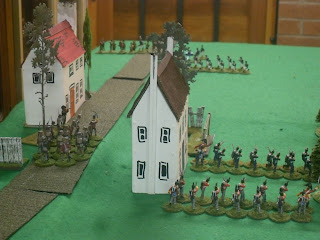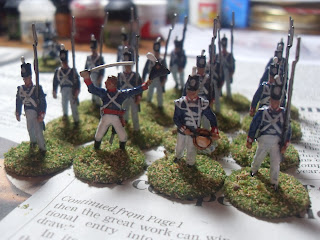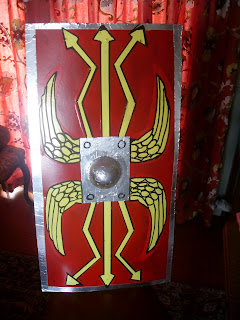Seconds out...first two rounds, of 15. In the Blue corner (US invaders):
On the right flank, a unit of US Regulars, an artillery battery, and a militia regiment. Their objective is to make the town too hot for the British-Canadian forces. After more pondering, I decided to reduce the points value of this militia unit to 10, as opposed to the 15 of 'One Hour' rules.
On the left, the US commander has put in his two best regiments of foot. Their objective is to take the hill.
Meanwhile, the centre is taken by this unit of US militia. Unlike the other regiment of militia, this has better morale and training (as represented by the fact that some of the figures are in uniform), and so has an initial points value of 12. Their task is to secure the woodlands. Under 'One Hour' rules, only 'skirmishers' can enter woodland, so the militia of both sides have been classed thus. Interestingly, the scenario set-up has this large woodland separating the two objectives of town and hill. Added to the fact that the defending force must keep two units within 12" of each objective, this introduces certain constraints.
In the Red (British-Canadian) corner, a militia unit rapidly advances down the turnpike into the town, with our Provincial cavalryman hero scouting ahead:
Skirting the edge of the town is a unit of Provincials and one of Regulars:
While another unit of Regulars takes to the hill:
and militiamen infiltrate the wood:
The scene is set; here, an overall view of the town:
Out in the fresh air, we have been having stormy weather in Old England, with high winds, heavy rain, and temperatures down to 10oC. In my tiny greenhouse, courgette seedlings stand ready for better weather and deployment to the allotment plot:




















































